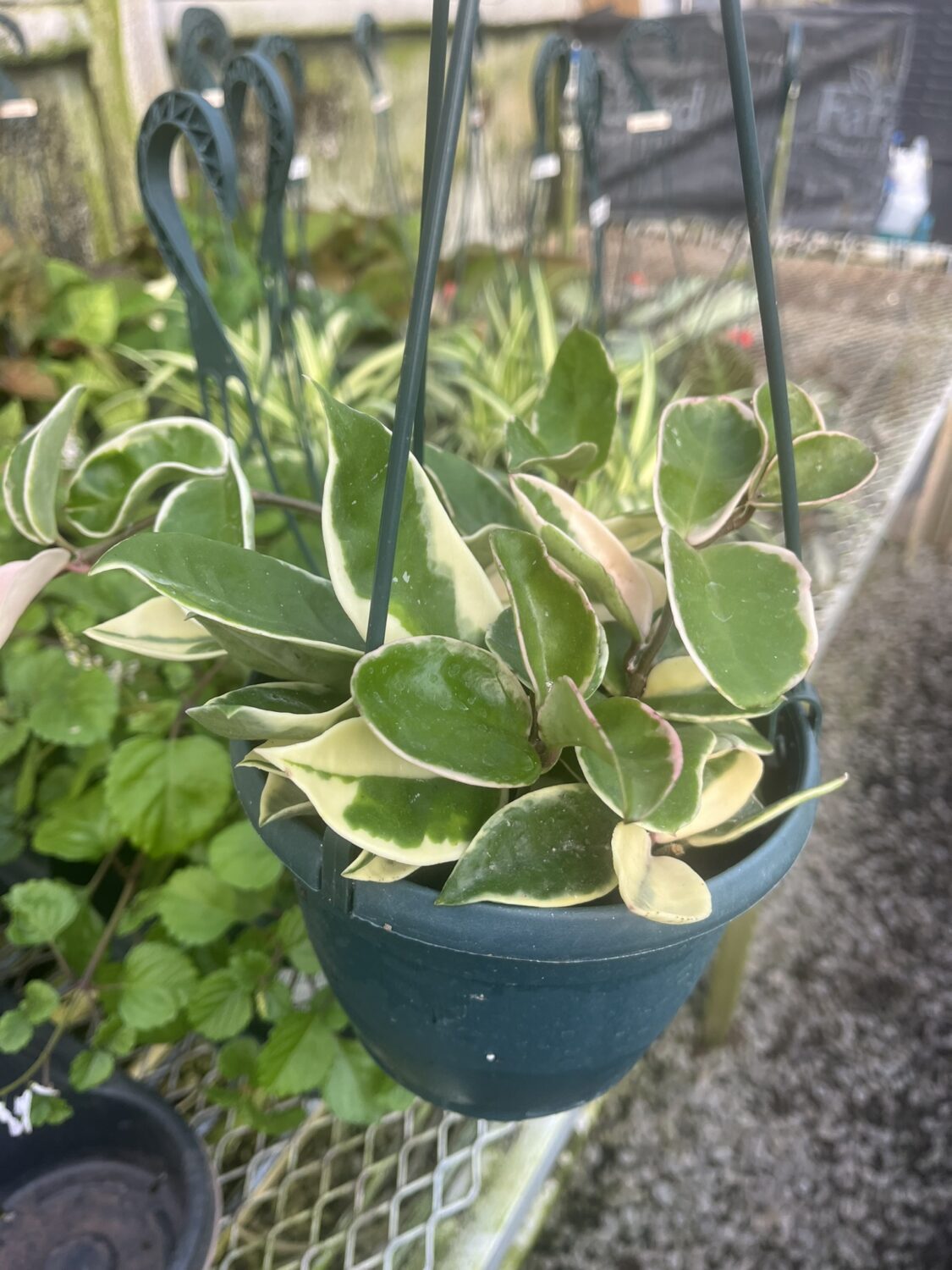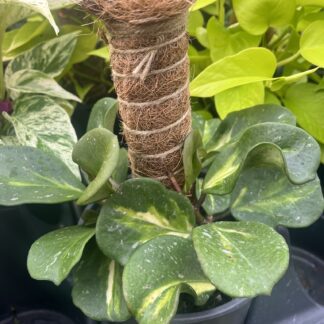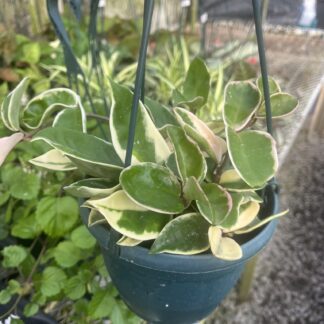Description
Hoya Carnosa ‘Krimson Queen’: Your Ultimate Guide to Growing and Loving This Beautiful Plant
Do you love plants with colorful leaves and easygoing personalities? Then let me introduce you to one of the most beautiful and rewarding houseplants around — the Hoya carnosa ‘Krimson Queen’. Also known as the Variegated Wax Plant, this tropical treasure is like a living piece of art that grows, climbs, and blooms right in your home.
Whether you’re just starting your indoor plant journey or you’ve been collecting for years, the Krimson Queen is a gem you’ll want to welcome into your space. It’s tough, it’s stunning, and it doesn’t ask for much — just a little care and a lot of love.
Let’s explore what makes the Hoya carnosa ‘Krimson Queen’ so special, and how you can help it thrive in your home.
What Is Hoya Carnosa ‘Krimson Queen’?
The Hoya carnosa ‘Krimson Queen’ is a type of wax plant, known for its shiny, thick leaves and trailing vines. It’s native to Southeast Asia and the Pacific Islands, where it grows in warm, tropical forests.
What sets the Krimson Queen apart is its variegation — the leaves have creamy white, soft pink, or even light yellow edges, with a rich green center. Some leaves are entirely white or pink, especially when they’re young. Over time, the plant can also produce clusters of tiny, star-shaped flowers that smell sweet and look like candy.
The Krimson Queen is both tough and beautiful — a rare combo in the plant world!
What Makes It So Unique?
🌿 Stunning Leaves
The leaves are what make this plant a queen. They’re waxy, semi-succulent, and come in a mix of green, cream, and pink. The colors are soft but eye-catching, and new leaves often come in bubblegum pink before they mature.
Each leaf is about 2–3 inches long and grows in pairs along thin vines. As the plant grows, these vines trail and twine, making it perfect for hanging baskets or tall trellises.
🌸 Sweet Flowers
After a few years, if your Krimson Queen is happy, it may gift you with flower clusters called umbels. Each cluster has up to 30 tiny, star-like flowers in pale pink or white, with deep red centers. They’re fuzzy, delicate, and smell lightly sweet, especially in the evening.
The flowers aren’t just pretty — they make your home feel even more magical.
🪴 Easygoing Growth
This plant grows slowly but steadily. Over time, its vines can reach 4 to 6 feet or more. It’s not in a rush — and that’s okay. It’ll be with you for years, even decades, if you treat it well. It’s a true houseplant companion.
You can let it hang, climb, or trail along a shelf. It’s a flexible friend.
Growing a Happy Krimson Queen: Step-by-Step Care Guide
Now that you’re excited to bring one home (or already have!), let’s look at how to care for your Krimson Queen so it can grow strong, colorful, and — one day — bloom!
☀️ 1. Light Needs
Your Krimson Queen loves bright, indirect light.
That means:
-
Near a sunny window, but not in direct sunlight.
-
A north- or east-facing window is perfect.
-
If it’s a south or west window, hang a sheer curtain to soften the light.
Too little light? The pink and white on the leaves may fade, and growth will slow.
Too much sun? The leaves might get burned.
Like Goldilocks — the light needs to be just right.
🌡️ 2. Temperature & Humidity
Think warm and cozy — like a tropical afternoon.
-
Ideal temps: 65–80°F (18–27°C)
-
Keep it away from cold drafts or windows in winter.
-
Never let it get below 50°F (10°C).
And don’t forget humidity!
The Krimson Queen loves 50% to 70% humidity. Here’s how to raise humidity:
-
Use a humidifier.
-
Group your plants together.
-
Set the pot on a tray of water and pebbles (make sure the pot doesn’t sit in the water).
Happy humidity = happy Hoya.
🪵 3. Soil Preferences
This plant doesn’t like soggy feet. It needs well-draining soil — that means water flows through easily and doesn’t sit around the roots.
You can use:
-
A cactus or succulent mix, or
-
Make your own mix:
-
1 part orchid bark
-
1 part perlite or pumice
-
1 part peat moss or coco coir
-
The goal? Moist, not wet. Let the soil dry a bit between waterings.
💧 4. Watering Tips
Watering can make or break your Hoya’s health.
Here’s the simple rule:
-
Let the top 2–3 inches of soil dry out before watering again.
-
In spring and summer, water more often.
-
In fall and winter, water less. Your plant is resting.
Always check before watering. Use your finger — if the soil feels dry up to your second knuckle, it’s time.
And always use a pot with drainage holes. No sitting water, please!
🌸 5. Feeding Your Queen
Yes, she likes to eat — but only a little, and only when she’s growing.
-
Use a water-soluble, balanced fertilizer (like 10-10-10 or 20-20-20).
-
Feed once every 4–6 weeks during spring and summer.
-
In fall and winter, you can skip the fertilizer.
Want flowers? Try a bloom booster fertilizer with more phosphorus (P).
✂️ 6. Pruning & Tidying Up
Don’t be afraid to give your plant a little haircut now and then.
-
Trim back long, leggy vines to make it fuller.
-
Remove yellow or dead leaves.
-
Wipe the leaves gently with a damp cloth to keep them shiny.
Important: If your plant blooms, don’t cut off the flower stems (called peduncles). New flowers often grow from the same spot again.
🌱 7. Propagating: Share the Love
Want more Krimson Queens? Great news — you can grow new ones from cuttings!
Here’s how:
-
Cut a vine 4–6 inches long with 2–3 nodes.
-
Remove the leaves near the bottom.
-
Place the cutting:
-
In water, or
-
In moist soil or moss.
-
-
Keep it in bright, indirect light.
-
Add humidity (a bag or dome works great).
-
In 3–4 weeks, roots should appear!
Once the roots are 1–2 inches long, plant it in a small pot with well-draining soil.
Voilà! A new Krimson Queen.
🐛 8. Pests and Problems
Even queens have enemies. Here’s what to watch for:
Pests:
-
Mealybugs (white cottony stuff)
-
Spider mites (tiny dots and webbing)
-
Aphids (small green bugs)
What to do:
-
Wipe leaves with a damp cloth.
-
Use insecticidal soap or neem oil spray.
Problems:
-
Yellow leaves? Too much water.
-
Drooping leaves? Could be too little water — or too much.
-
Brown tips? Dry air or too much sun.
Stay calm — small changes usually fix things.
🪴 9. Repotting
The Krimson Queen likes to be a little root-bound — snug in its pot.
But every 2–3 years, or when roots poke out, it’s time to repot.
Tips:
-
Choose a pot 1 size larger.
-
Use fresh, well-draining soil.
-
Water after repotting, but not too much.
This gives your plant room to grow and more energy to bloom.
🌼 10. Helping It Bloom
Want flowers? Be patient — it may take 2–3 years or more.
But here’s how to encourage blooms:
-
Give it plenty of bright, indirect light.
-
Keep it slightly root-bound.
-
Use a phosphorus-rich fertilizer in spring and summer.



